We came to Ito about four or five days ago (as I write this it will become more), we arrived by bus and two trains. When we finally arrived at Ito Station, Chisa, Masaki, Koshiro, Tojiro and Samuel (Samuel came in their car because they had a spare seat) were waiting. We took a detour route, passing by the supermarket and a kakigori shop. We stopped at both, and tasted for the first time kakigori which is a type of artificial snow. We all had a bowl of snow with, in the centre of the bowl, there was a big blob of mango snow. You might be thinking: “How can you possibly have mango snow?”. It’s simple: you make normal snow with water; you make mango snow with mango juice. Kakigori is really delicious. At the same shop, we also had a kind of pastry fish about 10 cm long, and it would be filled with either: half custard/half chocolate sauce, red bean paste, or red bean paste with a chestnut in the center. I preferred the half custard/half chocolate sauce one.
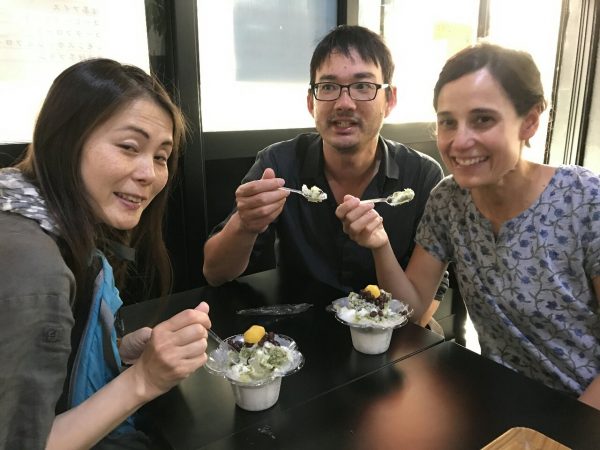
Adults eating kakigori

Children eating kakigori
Anyway, in the end we arrived at our hostel: K’s house. We had been staying in another K’s house in Kawaguchiko, our previous stop. I’ve learnt that every K’s house is different. Our first K’s house had two floors and a very small roof terrace. There was also a guest kitchen, and a small lounge, a laundry area, a computer and quite a few dining tables. Our K’s house in Ito was a hundred years old, had three floors, a very big onsen on the ground floor, a private onsen on each of the upper floors, a small glass dome on the roof where you could sit and observe the river and city, a guest kitchen, a laundry area, a computer, a couple of dining rooms (in each there were two four-seater tables) a lounge with books and games, and a TV in one of the dining rooms.
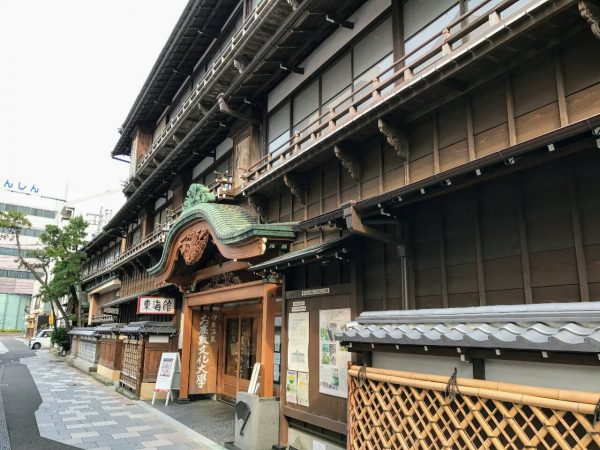
Our K’s house
Anyway, now you know what the “K’s” look like, we can continue with what happened. Our K’s house in Ito is very special because it has onsen. Onsen is Japanese for “hot springs”. Ito is famous for it’s onsen. We loved the hot springs. They were a lot better than in Thailand.
Here is the list of the advantages of the Thai hot springs:
- They’re outdoor so you get fresh air
- There are lots of tubs at different temperatures, so you can choose which one you like best
Here are the advantages of the Japanese onsen:
- It’s indoor, and I like indoors.
- It’s big
- It’s clean
- It’s comfortable
- You don’t have other people’s dirt in the bath
Here are the disadvantages of the Thai hot springs:
- They’re dirty
- They’re small
- They’re in little concrete tubs
- There are lots and lots of insects
- They smell REALLY bad
Here are the disadvantages of the Japanese onsen:
- It’s inside so you have to keep getting up to get fresh air because of all the steam
- There is only one tub so you can’t change temperature.
Here is the rule of the Thai hot springs:
- You are not allowed to be naked.
Here are the rules of the Japanese onsen:
- You have to be naked- no swimming costume allowed.
- You change in the locker room, not in the bathroom.
- You put your clothes in the baskets or the lockers.
- You take your towel with you down to the onsen.
- You shower and soap BEFORE you get into the onsen.
- You shower sitting down, so as not to splash anyone else.
- You put your stool away after you are finished showering.
- You don’t put your towel in the bath.
- You put your towel on your head.
- No hair in the bath.
- Do not splash about in the bath.
- The onsen is a bath, not a swimming pool.
- Be considerate about others.
- Dry yourself before you go up to the locker room, so as to keep the locker room dry.
- No phones, cameras, or photography allowed.
I think that those are all of them. There are quite a lot compared to the Thai rule!
But, I’ve only just started about what what we did. I’d better continue! No more distractions. So, we stayed in Ito five nights, and mostly, we walked lots and lots. After our first night in the hostel, we took the train to a place by the coast. When we got off the train, it was raining heavily, (though it was raining when we left the hostel) so we went into the train station and waited for the rain to stop. While we waited, we ate rice balls.
When we left the station, it was only raining lightly, and by the time we got to the coast, which was about a kilometre away, it was as sunny as could be. We walked a bit along the coast, and after having found a lighthouse and a suspension bridge across a cove, we turned around and headed off in the opposite direction. The bottom of the lighthouse was at 24.6 m above sea level, and I don’t know how far up the top was, it was so far up. When you were going up, it would seem like you were eternally going up, up, up… and when you were coming down, it would seem like the bottom was around every next corner, you had come down so far… but it wasn’t. And the suspension bridge, we learnt something quite funny about it – about how you measure weight in Japan. There was a sign next to the bridge that said: 100, then something in japanese, then underneath it, it said 30, then something else in Japanese. Chisa told us that the “100” bit meant that it had a limit of 100 people, and the “30” part meant that only 30 Sumo wrestlers could go on it, because Sumo Wrestlers are about 3 times as heavy as normal people. I’m guessing that they used to measure weight in sumo wrestlers in the old days.
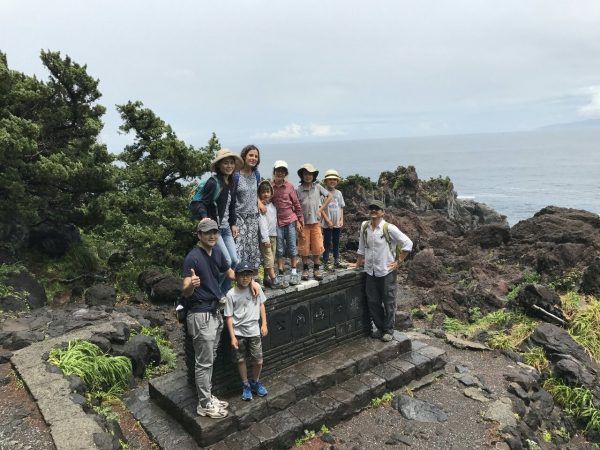
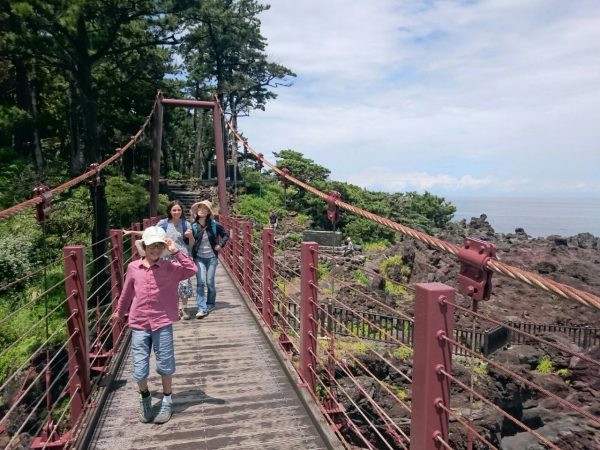
The suspension bridge
So, now I’m going to continue about what we did in the other direction. After a couple of kilometres, we came to a car park, where there was an soft-scoop ice-cream shop, where we all had one. It was the second time I tasted soft-scoop in my life, and it was even more delicious than the first time. Japanese soft-scoop really has something unique about it. Then, we walked a few more kilometres, and then we came to a lookout point overlooking a waterfall. We stayed there a good forty-five minutes, well at least some of us did; we had kind of separated into three groups- the first group had 45min, the second group had forty, and the third had 30. Then, after another few kilometres, we went down a steep path to some rocks which were far below the cliffs that we had been walking on. Amongst the rocks, there were a few large rock-pools, in which everyone apart from Chisa, Elliot and I swam in.
From the moment we came down to the rocks, I knew it was a bad idea. It turned out that I was right! I was right because when Tojiro came out of the rock-pool, his foot was really hurting, and we discovered that he had several sea urchin spines in his foot. As we couldn’t get them out, Masaki set off for the nearest town to get some tweezers while we got Tojiro dressed and let him rest. When Masaki got to the town, he contacted us and told us the way. On the way to the town, we bumped into Masaki, and he had some tweezers. Both Daddy and Masaki tried to take out the spines, but they couldn’t manage. So then Chisa carried Tojiro, and we walked to the town clinic, but it was closed. Luckily, we spotted a doctor leaving in his car, and he gave Chisa the hospital’s number and told her that it would be easier to go to the hospital in Ito.
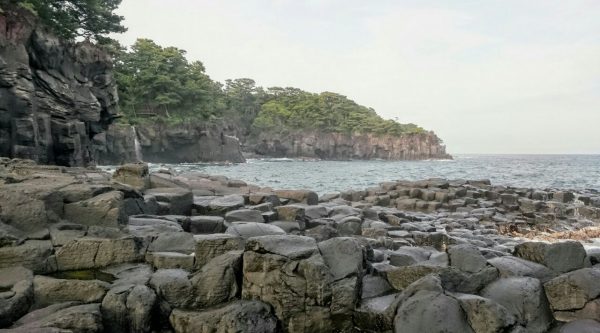
What it looked like where we swam
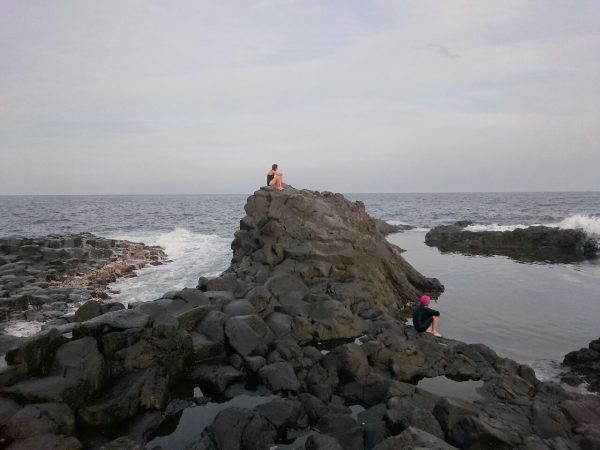
On the right, the pool which everyone swam in.
So then we all went back to Ito on the train, and when we arrived at Ito, Chisa, Masaki and Tojiro went to the hospital while the rest of us went to the supermarket and we got things for dinner which was to be pasta. Just thinking of it makes my mouth water. While we were half-way through our meal, Tojiro, Chisa and Masaki returned. Apparently, the doctors couldn’t pull it out either, so they put some anesthetic on him and cut his foot open then they took all the spines out and stitched it back together. Luckily, he didn’t feel any pain, but he had to watch the whole operation under his eyes. He ate some pasta, then we all went to bed. The pasta was probably among the nicest foods I’ve eaten in my time in Japan.
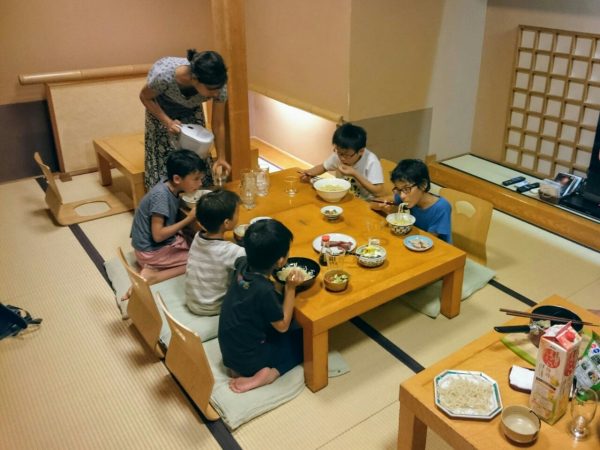
Our meal of pasta
All the adults were worried that the anesthetic would have worn off by the morning, but when Tojiro came to join us playing Scratch in the morning, he seemed fine. He was even walking, though only on one one foot. That evening, we went to a sushi train restaurant. A sushi train restaurant is, obviously, a place where you get sushi. Basically, you sit at a table, and on one side of the table, there is a conveyor belt on which plates of sushi go round and round on, a bit like the Baggage Claim at an airport. Then, you can just take one off the conveyor bet, and then eat it! In the one we went to in Ito, (we’ve been to three) there was also a little screen at every table, and on it you could order which sushi you would like , and they put it on the conveyor belt and when it nears your table the screen emits a little song and on the screen it shows a picture or the dish, and you pick up the dish and eat it! And you count up how much you pay by counting your plates; 100¥ for a normal plate, 200¥ for a special plate, and 380¥ for an ultra big or special plate (like a coconut). At sushi restaurants, I take more cucumber rolls than anything else. S0, that day, all we did (apart from the sushi train restaurant) was play around on the beach and relax at the hostel, but Mama (The walking devil) had devised a plan for the following day…

A sand volcano

Playing in the sand
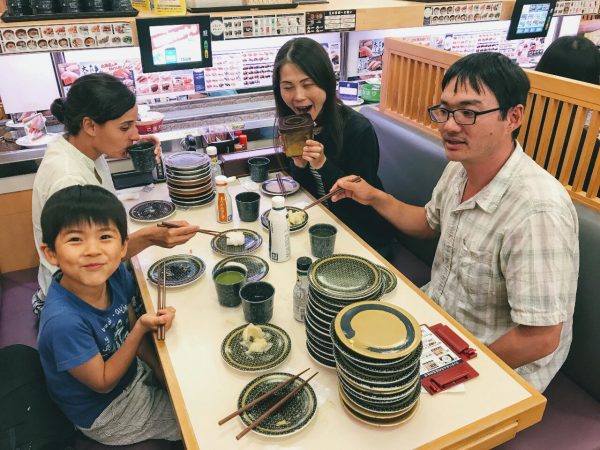
The sushi train restaurant
MOUNT OMURO
Mama had planned for us to climb Mount Omuro. You may be thinking: “How is that a plan, and anyway how can Tojiro climb up it?”, but Mama had planned it all: we walk up, while Chisa and Tojiro take the chairlift. But… her plan failed! Here is what happened: Koshiro, Samuel, Masaki, Daddy and I took the bus to a special market near Mount Omuro, and we waited there until Mama and Elliot arrived in the car. Then, after watching some dances and eating some corn on the cob, we walked to Mount Omuro, and started walking to the place where there would be a path which we would walk up to get to the top of Mount Omuro. But we couldn’t find the path! We saw another man walking in the opposite direction. Daddy and Masaki asked him if he knew where the path was, and he told us that Mount Omuro had been bought by a private company, and they didn’t want people walking up it because it would wear down the ground and make trenches in the delicate soil, so they say that you’re not allowed to walk up Mount Omuro. Everyone thought it was ridiculous, but we ended up taking the chairlift up. YAY! At the top of the mountain, we met up again with Chisa and Tojiro. Then, we walked around the crater, (a one-kilometre walk) and took the chairlift down. Then, Daddy, Mama, Chisa, Tojiro and Elliot went away in the car while Masaki, Samuel, Koshiro and I waited ten minutes for the bus, which took over forty minutes to get back to the hostel. When we got back… we took an Onsen!
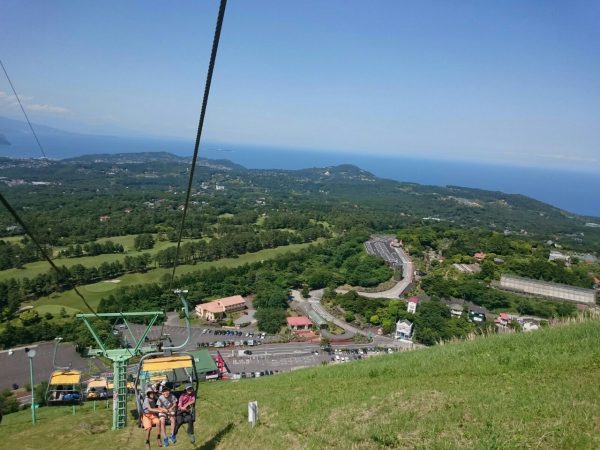
The chairlift up Mount Omuro
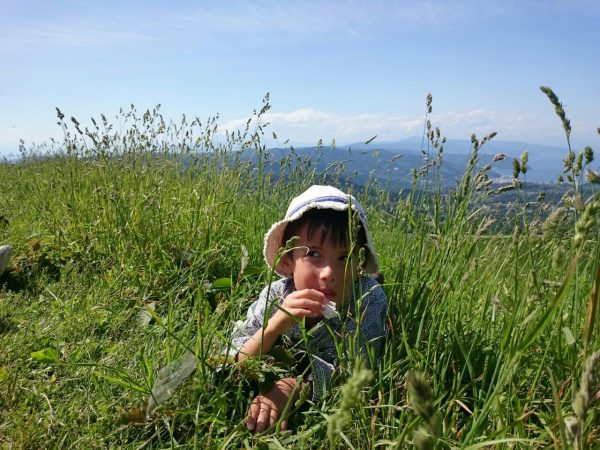
Pick-nicking in the grass
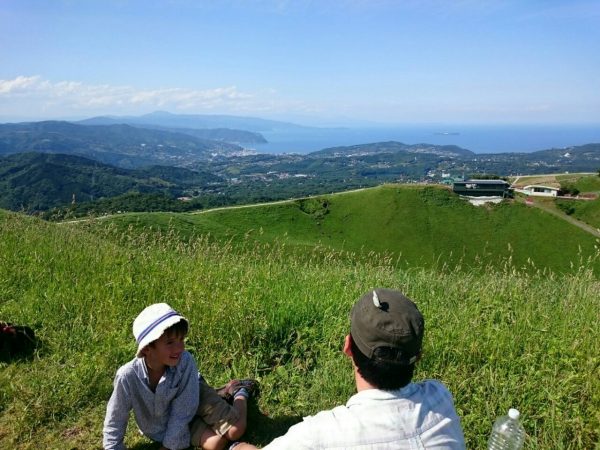
The view from halfway around the crater
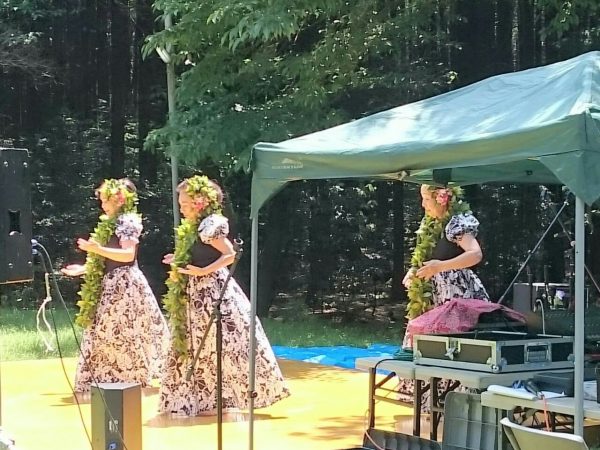
A Hawaiian dance
GOODBYE
The next morning, the Odas left. But, as soon as they left Mama and Daddy made us go on a fourteen kilometre walk up and down and around hundreds and hundreds of hills!!! I really hate how they are always dragging us along onto long, long, long, long, long, long, long, long, long, long, long, long, walks. Especially how they started off saying that we were going to the beach. Then Mama said that she needed to go to the shops. Then after we went to the shops, Daddy said that we should go for a walk around town. Then, they said that we should go and look at a park a bit up the hill. Then,at the park, we had lunch (onigiri (rice balls)), then they said thatwe should climb up to the “High Point”, the peak of the mountain that towers over Ito. Then, at the top of that, they decided towalk on further. Like I said before, by the time we got back, wehad walked fourteen kilometres- and we were still in flip-flops!!! We stayed one last night at the hostel. The following day, we just lazed around and played on the beach, and even had an onsen– even though we had already checked out, the guy at the desk let us have one last hot spring bath. Then, that evening, we walked to the station and caught our train which we took to another train which we took to an 8-hour overnight bus to Kyoto. At 5:30 am that morning we walked eleven kilometres up a hill.
But that is another story…
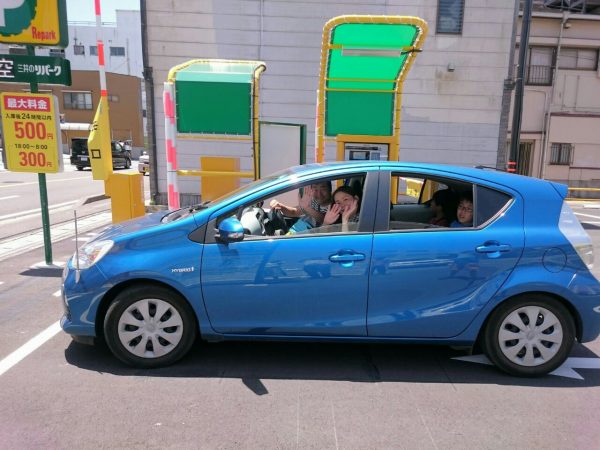
The Odas leaving in their car
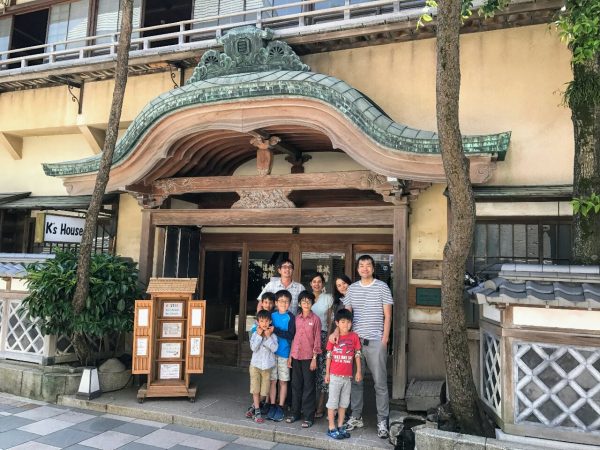
One of the staff took a picture of us on the day the Odas left.

Hi!
What an enriching experience. I’m intrigued with onsen — what else does it do apart from making you squeaky clean? Is it bubbling like a jacuzzi? Does it make you strong and ready to walk all day or relax and sleepy?
Lovely photos of you, Chisa and family and those stunning landscapes. Thanks!
Xxx